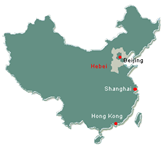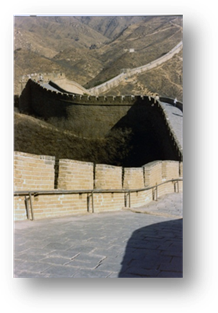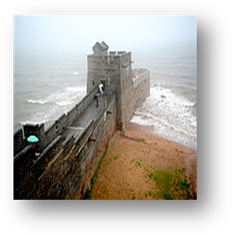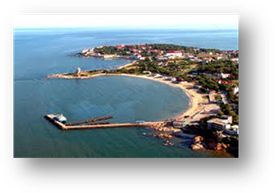News & Updates
Lotus - A trusted name in family travel
Hebei Province
 The name Hebei means "north of the river", referring to its location completely above the Yellow River. It was formed in 1928, after the central government dissolved the province of Chih-li (直隸), which means "Directly Ruled (by the Imperial Court)". Beijing first became the capital of all of China under the expansionist Yuan rulers during the Tan dynasty (618 – 907BC).
The name Hebei means "north of the river", referring to its location completely above the Yellow River. It was formed in 1928, after the central government dissolved the province of Chih-li (直隸), which means "Directly Ruled (by the Imperial Court)". Beijing first became the capital of all of China under the expansionist Yuan rulers during the Tan dynasty (618 – 907BC).
Culturally and economically, Hebei is one of the most advanced provinces in northern China and is home to an estimated 72 million people. The ethnic composition of the population is almost entirely Han (Chinese). There are a couple of minority groups, which are the Man (Manchu); the Hui (Chinese Muslims)’ and a tiny percentage of Mongols. The great majority of adults are literate and the province has more than 30 institutions of higher education. With its location so near to the pivotal capital of the country, the province hsas worked to upgrade the technical level of its citizenry in a push toward modernization.
http://www.sciencekids.co.nz/sciencefacts/engineering/greatwallofchina.html


Though the province covers a vast area with almost 75,000 square miles, it is somewhat overshadowed by its neighbors, Beijing and Tianjin, which were carved out of the province as separate, huge municipalities. In the 1960s the emergence of the Huabei oil fields made this locale a major oil producer and was the impetus for creating Tianjin as a separate municipal district.
Hebei Province boasts of having the longest, the best preserved and the highest architectural quality sections of the Great Wall. It is considered a key pivot point for the Great Wall and its history.
History of the Great Wall
 The most iconic monument in all China, the Great Wall stands as an awe-inspiring symbol of the grandeur of China’s. The Great Wall was continuously built from the 3rd century BC to the 17th century AD on the northern border of the country as the great military defense project of successive Chinese Empires. The Great Wall begins in the east at Shanghaiguan in Hebei province and ends at Jiayuguan in Gansu province in the west. It consists of walls, horse tracks, watch towers and shelters, including fortresses and passes along the length of it.
The most iconic monument in all China, the Great Wall stands as an awe-inspiring symbol of the grandeur of China’s. The Great Wall was continuously built from the 3rd century BC to the 17th century AD on the northern border of the country as the great military defense project of successive Chinese Empires. The Great Wall begins in the east at Shanghaiguan in Hebei province and ends at Jiayuguan in Gansu province in the west. It consists of walls, horse tracks, watch towers and shelters, including fortresses and passes along the length of it.
A report by China's State Administration of Cultural Heritage in 2009 put its total length at more than 5500 miles. Meandering its way through 17 provinces, principalities and autonomous regions, the wall started out as a line of defense against the Mongol hordes. Though it has had no real practical use for centuries, it retains its place in the imagination of both locals and foreigners.
 There are, in fact, five distinct Walls, if you count the recently built sections, such as Badaling. Work on the original was begun during the Qin Dynasty, when China was unified for the first time under the Emperor Qin. Hundreds of thousands of workers, many of them prisoners, labored for more than 10 years to unite various sections of it. An estimated 180 million cubic meters of rammed earth was used to form the core of this Wall. Legend has it that the bones of dead workers were used as building materials, too.
There are, in fact, five distinct Walls, if you count the recently built sections, such as Badaling. Work on the original was begun during the Qin Dynasty, when China was unified for the first time under the Emperor Qin. Hundreds of thousands of workers, many of them prisoners, labored for more than 10 years to unite various sections of it. An estimated 180 million cubic meters of rammed earth was used to form the core of this Wall. Legend has it that the bones of dead workers were used as building materials, too.
After Qin died, work on the wall continued during the Han Dynasty (206BC-AD220). Little was done until almost 1000 years later during the Jin dynasty when the impending threat of Genghis Khan spurred further construction. The Wall's final incarnation, and the one most visitors see today, came during the Ming Dynasty (1368-1644), when it was reinforced with stone, brick and battlements over a period of 100 years, at great human cost to the two to three million people who toiled on it. During this period, it was home to around one million soldiers.
 The great irony of the Wall is that it rarely stopped China's enemies from invading. Never one continuous structure, there were inevitable gaps and it was through those that Genghis Khan rode in to take Beijing in 1215. Perhaps the Wall's finest hour as a defensive bulwark came in 1644 at Shanhaiguan, where the Wall meets the sea in the east and guarded the approach to Beijing. The invading Manchus were unable to take this strip of Wall until the traitorous General Wu Sangui opened the gates and let the enemy in, which resulted in the fall of the Ming dynasty.
The great irony of the Wall is that it rarely stopped China's enemies from invading. Never one continuous structure, there were inevitable gaps and it was through those that Genghis Khan rode in to take Beijing in 1215. Perhaps the Wall's finest hour as a defensive bulwark came in 1644 at Shanhaiguan, where the Wall meets the sea in the east and guarded the approach to Beijing. The invading Manchus were unable to take this strip of Wall until the traitorous General Wu Sangui opened the gates and let the enemy in, which resulted in the fall of the Ming dynasty.
The Wall cuts through northern Hebei from east to west, briefly touches the border of the Beijing Municipality, and ends at the seacoast of Shanhaiguan in northeastern Hebei. Shanhaiguan Pass is also called 'The First Pass Under Heaven.
Built in 1381 in the Ming Dynasty (1368-1644), Shanhaiguan has a very well preserved ancient city wall. Now, however the pass has become a famous attraction in China. At one time, this section of the Great Wall was a key part of the defensive system for the empire. As a Chinese saying goes, 'He who has never been to the Great Wall is not a true man.' There is truth in this saying because, once you visit the Shanhaiguan Pass, one can realize an immediate understanding of the military power of ancient China.
Click First Pass Under Heaven for more on Shanhaiguan Pass.
Other Sites in Hebei Province
 Visitors who want to experience other cultural relics in this beautiful province may wish to explore the Mountain Resort of Chengde, which used to be the largest royal summer resort of the Qing Dynasty (1644-1911). Outside the surrounding wall of the Mountain Resort, one can view the largest imperial temples in all of China, which are called the Eight Outer Temples.
Visitors who want to experience other cultural relics in this beautiful province may wish to explore the Mountain Resort of Chengde, which used to be the largest royal summer resort of the Qing Dynasty (1644-1911). Outside the surrounding wall of the Mountain Resort, one can view the largest imperial temples in all of China, which are called the Eight Outer Temples.
Another key site is sometimes referred to as “Beijing’s backyard garden”, but is formally called the Mulan Paddock. It was used as the hunting place for the emperors of the Qing Dynasty. It is currently a lovely and natural grassland resort, which is perfect for those visitors who are after a bit of fresh air and peaceful countryside, but who do not have time to travel to the more rugged grasslands of Inner Mongolia. In the summertime, one can arrange to sleep at the Paddock in one of the Mongolian Yurts, or do horseback riding, hiking or climbing.


If one wants to visit Hebei province at different seasons, one can enjoy the sunshine, beaches, and beautiful fresh air blowing in from the Bohai Gulf which is a relatively short distance from Beijing and its smog. In springtime one can ride on the vast and magnificent grassland of the Mulan Paddock. In winter, another spectacular destination in Baoding City with Baiyang Lake that boasts unique scenes of reeds and snow, which creates a scene reminiscent of the phrase “Winter Wonderland”.
Key Cities
 Hebei is at the center of China’s vast north-south railway network, and all of its major cities are connected by rail. The port city of Qinhuangdao is one of the country’s most important trade entry ports and has a long history as one of China’s “open” coastal cities. It has a beautiful coastline and has an ideal ecology, so it is considered an ideal summer resort area in China, because of its ideal location, facing the Bohai Sea. Nearby spots of interest include the Shnahaiguan Pass and the Seidaihei Scenic Spot. The city has played a key role in the country’s foreign trade and investment. Qinhuangdao also has the unique honor of being nicknamed "the glass city" because Qinhuangdao Yaohua Glass Co. is one of the most important companies and it is central to the economy.
Hebei is at the center of China’s vast north-south railway network, and all of its major cities are connected by rail. The port city of Qinhuangdao is one of the country’s most important trade entry ports and has a long history as one of China’s “open” coastal cities. It has a beautiful coastline and has an ideal ecology, so it is considered an ideal summer resort area in China, because of its ideal location, facing the Bohai Sea. Nearby spots of interest include the Shnahaiguan Pass and the Seidaihei Scenic Spot. The city has played a key role in the country’s foreign trade and investment. Qinhuangdao also has the unique honor of being nicknamed "the glass city" because Qinhuangdao Yaohua Glass Co. is one of the most important companies and it is central to the economy.

Shijiazhuang, the capital of Hebei province, has some interesting historical contributions to modern China. The city hosted the inception of modern China's financial system as the birthplace of the currency renminbi. The People's Bank of China, the nation's central bank also began there and the surrounding nearby rural area was one of the first meeting places of the Communist forces, before coming to power. As the economic, political, cultural and scientific center of Hebei Province, Shijiazhuang is becoming more and more beautiful with recent urban development. A jade-like moat embraces the city gently, bordered by 20 charming parks. This beautiful city is filled with culture and development. The city is home to many significant cultural relics, such as the oldest stone-arch bridge in China, Zhaozhou Bridge.
There are several interesting cities and sights to spend time exploring in Hebei province, but of course, the most famous is the Great Wall. Contact info@lotustours.net to ask about arranging any locale in Hebei that your family may wish to visit!
Sources:
Encyclopedia Britannica; Aboutculture.co; UNESCO World heritage site; various internet sources